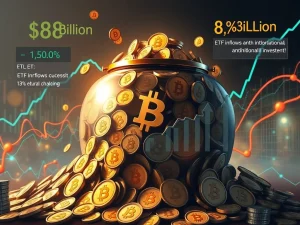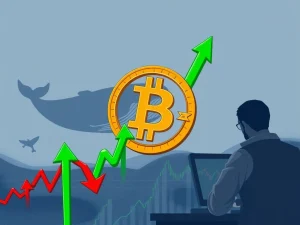Decoding Bitcoin’s Next Leap: Trader Sentiment Shifts After BTC Halving

Are you trying to navigate the volatile world of cryptocurrency trading? Understanding market sentiment and the Bitcoin halving cycle can provide crucial insights into potential price movements. Recent shifts in Bitcoin traders’ sentiment, particularly among long-term holders and whales, suggest we might be on the cusp of a new phase in the BTC halving cycle. Let’s dive into what these shifts mean for Bitcoin’s future.
Understanding the Bitcoin Halving Cycle and Market Phases
The Bitcoin halving cycle, occurring roughly every four years, is a cornerstone of Bitcoin’s economics. It reduces the reward for mining new blocks, effectively decreasing the rate at which new Bitcoin enters circulation. This event is widely believed to influence Bitcoin’s price trajectory, leading to predictable market phases:
- Accumulation Phase: Smart money and long-term investors buy Bitcoin, often during or after bear markets.
- Parabolic Rallies: Driven by increased demand and often fueled by halving hype, Bitcoin experiences rapid price appreciation.
- Market Corrections (Crashes): After rallies, markets typically cool down, leading to corrections or more significant price drops.
Within this broader four-year Bitcoin halving cycle, shorter cycles emerge, shaped by market sentiment and the actions of different holder cohorts. By analyzing these micro-cycles, we can gain a clearer picture of Bitcoin’s potential next steps.
Long-Term Holders: Accumulation Signals in the Bitcoin Market
Long-term holders, defined as those holding Bitcoin for three to five years, are considered seasoned market participants. Their behavior often provides clues about market direction. These investors tend to:
- Weather Bear Markets: They possess the experience and financial capacity to hold through prolonged downturns.
- Sell Near Tops: They are adept at identifying market peaks and taking profits.
- Re-accumulate During Dips: After selling, they often buy back Bitcoin during price corrections, strengthening market stability.
Currently, data indicates that long-term holders are in a new accumulation phase. Since mid-February, their Bitcoin holdings have increased significantly, by nearly 363,000 BTC. This accumulation suggests a belief in Bitcoin’s long-term value and potential for future price appreciation.
Bitcoin Whales: Mega-Whales Lead the Charge
Bitcoin whales, addresses holding over 1,000 BTC, represent another influential group. Mega-whales, holding over 10,000 BTC, are at the very top. Their recent activity points to strong accumulation. Key observations include:
- Perfect Accumulation Score: Large whales briefly achieved a perfect accumulation score in early April, indicating intense buying.
- Consistent Accumulation: Even after easing slightly, their accumulation score remains high, showing continued buying pressure.
- Buying from Retail: Whales appear to be acquiring Bitcoin from smaller holders (wallets with less than 1 BTC and under 100 BTC), whose accumulation scores have decreased.
This divergence—whales accumulating while smaller holders distribute—often precedes bullish periods. Historically, mega-whale accumulation has been a precursor to significant price rallies. The last time mega-whales showed such strong accumulation was in August 2024, before Bitcoin surged to $108,000 (based on the article’s example timeframe which seems to be projecting into the future – assuming a typo and meant to be past data). This current trend could signal similar upward potential.
Short-Term Holder Sentiment: Fear and Potential Capitulation
Bitcoin sentiment is heavily influenced by short-term holders (those holding BTC for 3 to 6 months). They are more reactive to market fluctuations and prone to selling during downturns. However, current data reveals an interesting scenario:
- Historically Low Spending: Despite market turbulence, short-term holders’ spending activity is unusually low.
- Holding Strong (So Far): Many newer Bitcoin buyers are choosing to hold rather than panic-sell, demonstrating resilience.
- Capitulation Risk: If Bitcoin prices decline further, short-term holders might trigger a sell-off, potentially accelerating a price drop.
The Fear & Greed Index reflects the prevailing market Bitcoin sentiment. It has been in fear or extreme fear territory since February, exacerbated by global economic uncertainties. However, market psychology is cyclical. A shift towards neutral sentiment in the coming months is plausible, which could stabilize or improve market conditions.
Market Cycles: A Self-Fulfilling Prophecy?
The cyclical nature of markets, especially in cryptocurrency, can become self-reinforcing. When market participants anticipate patterns, their actions based on these expectations can solidify those very patterns. In the case of market cycles and Bitcoin:
- Belief in Cycles: Widespread belief in Bitcoin’s four-year cycles influences trading behavior.
- Profit Taking and Dip Buying: Traders sell at anticipated peaks and buy during expected dips, reinforcing the cycle.
- Shaping Reality: This collective behavior adds to the persistence of Bitcoin’s cyclical movements.
While Bitcoin cycles may not adhere to rigid timelines, their consistent rhythm shapes market expectations and, consequently, market reality. Understanding these cycles and the sentiment shifts within them is vital for navigating the cryptocurrency landscape.
Conclusion: Navigating the Next Phase of the Bitcoin Cycle
The current market dynamics, characterized by long-term holders and Bitcoin whales accumulating alongside subdued short-term holder spending, suggest a potential shift towards the next phase of the Bitcoin halving cycle. While market sentiment remains fearful, historical patterns indicate that accumulation by large players often precedes bullish movements. Keeping a close watch on these sentiment shifts and holder behaviors can provide valuable insights for informed decision-making in the exciting, yet unpredictable, world of Bitcoin trading.
Disclaimer: This article is for informational purposes only and does not constitute investment advice. Cryptocurrency investments are highly risky, and you should conduct your own thorough research before making any investment decisions.









